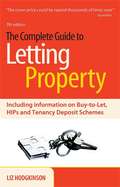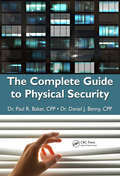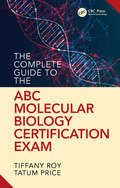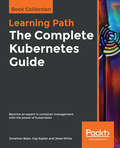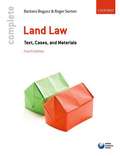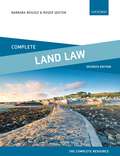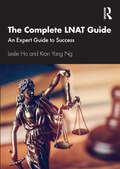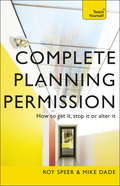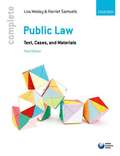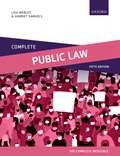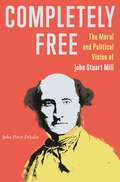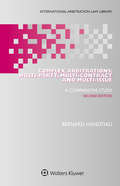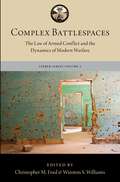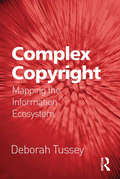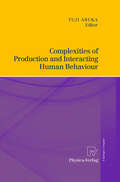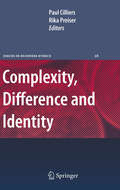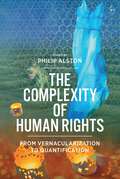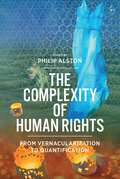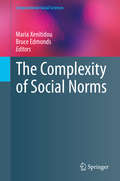- Table View
- List View
The Complete Guide to Letting Property: Including Information on Buy-to-let, HIPs and Tenancy Deposit Schemes (7th edition) (PDF)
by Liz HodgkinsonDespite the current financial climate, this book demonstrates how buying property to let can still be a sensible and profitable investment option.The Complete Guide to Letting Property includes comprehensive information on rental legislation including: the Tenancy Deposit Scheme, HIPs, safety and energy requirements for rental properties, and Landlord Accreditation Schemes. It provides reliable advice on all aspects of becoming a landlord, from choosing the right type of property and calculating finances to selling a rental investment that has sitting tenants.In-depth discussion of the advantages and disadvantages of buying offplan, both in the UK and abroad, as well as the important elements involved in guaranteed rental schemes, ensure that this guide is a must-read if you are considering letting a property.
A Complete Guide to Maggot Therapy: Clinical Practice, Therapeutic Principles, Production, Distribution, and Ethics
by Frank StadlerSince the revival of maggot therapy in Western wound care approximately thirty years ago, there has been no comprehensive synthesis of what is known about its clinical practice, supply chain management, and social dimensions. This edited volume fills the information vacuum and, importantly, makes the current state of knowledge freely accessible. It is the first to provide sound, evidence-based information and guidance covering the entire supply chain from production to treatment. The chapters are arranged in five parts presenting the latest on clinical practice, the principles of therapeutic action, medicinal maggot production, distribution logistics, and the ethical dimensions of maggot therapy. The contributors have paid particular attention to the challenges encountered in compromised, low-resource healthcare settings such as disasters, conflict, and poverty. There are still many barriers to the widespread uptake of maggot therapy in healthcare settings. This book will be essential reading for a global audience of doctors, nurses, allied healthcare providers, students, and entrepreneurs with an interest in maggot-assisted wound care. It will be the go-to reference for those who plan, regulate, and coordinate healthcare, and want to establish a maggot therapy program, particularly in low- and middle-income and other compromised healthcare settings where maggot therapy can provide much-needed, affordable, and efficacious wound care.
The Complete Guide to Physical Security
by Paul R. Baker Daniel J. BennyTo adequately protect an organization, physical security must go beyond the "gates, guns, and guards" mentality that characterizes most security programs. Creating a sound security plan involves understanding not only security requirements but also the dynamics of the marketplace, employee issues, and management goals. The Complete Guide to Physica
The Complete Guide to Physical Security
by Paul R. Baker Daniel J. BennyTo adequately protect an organization, physical security must go beyond the "gates, guns, and guards" mentality that characterizes most security programs. Creating a sound security plan involves understanding not only security requirements but also the dynamics of the marketplace, employee issues, and management goals. The Complete Guide to Physica
The Complete Guide to the ABC's Molecular Biology Certification Exam
by Tiffany RoyIn 2009, the National Academy of Sciences (NAS) authored the report Strengthening Forensic Science in the United States: A Path Forward. In it, the Committee expressed the need for accreditation and certification. Accreditation, long recognized by public labs as an important benchmark in quality, was recognized as an important way to standardize laboratories that provide forensic services. Certification can play an important role as a method of oversight in the forensic sciences—something also recommended by the - National Commission on Forensic Science in October 2014. The Complete Guide to the ABC's Molecular Biology is a professional certification examination preparation text for forensic scientists taking the American Board of Criminalistics Examination in Molecular Biology. The book serves as a resource for forensic scientists—who are facing more and more pressure to become certified—to support them in their pursuit of forensic certification. In the years since the NAS report was published, there has been increased discussion of forensic certification requirements. ABC’s Molecular Biology exam is a quality certification, and learning the concepts for it will invariably help any professional working in the field. The book prepares readers in all relevant topic areas, including: accreditation, safety, biological screen principles, anatomy and cell biology, crime scene and evidence handling, concepts in genetics, biochemistry, statistics, DNA evidence, and DNA testing. The book will be particularly helpful for forensic science laboratory technicians, police and investigations professionals, forensic serology and DNA analysts, attorneys, and forensic science students. This study guide follows the guidelines for the exam and presents all the information necessary to prepare individuals to pass the exam.
The Complete Guide to the ABC's Molecular Biology Certification Exam
by Tiffany RoyIn 2009, the National Academy of Sciences (NAS) authored the report Strengthening Forensic Science in the United States: A Path Forward. In it, the Committee expressed the need for accreditation and certification. Accreditation, long recognized by public labs as an important benchmark in quality, was recognized as an important way to standardize laboratories that provide forensic services. Certification can play an important role as a method of oversight in the forensic sciences—something also recommended by the - National Commission on Forensic Science in October 2014. The Complete Guide to the ABC's Molecular Biology is a professional certification examination preparation text for forensic scientists taking the American Board of Criminalistics Examination in Molecular Biology. The book serves as a resource for forensic scientists—who are facing more and more pressure to become certified—to support them in their pursuit of forensic certification. In the years since the NAS report was published, there has been increased discussion of forensic certification requirements. ABC’s Molecular Biology exam is a quality certification, and learning the concepts for it will invariably help any professional working in the field. The book prepares readers in all relevant topic areas, including: accreditation, safety, biological screen principles, anatomy and cell biology, crime scene and evidence handling, concepts in genetics, biochemistry, statistics, DNA evidence, and DNA testing. The book will be particularly helpful for forensic science laboratory technicians, police and investigations professionals, forensic serology and DNA analysts, attorneys, and forensic science students. This study guide follows the guidelines for the exam and presents all the information necessary to prepare individuals to pass the exam.
The Complete Kubernetes Guide: Become An Expert In Container Management With The Power Of Kubernetes
by Jonathan BaierThis Learning Path walks you through the basic and advanced features of Kubernetesand teaches you all that you need to know for easily and efficiently manage your containerized applications.
Complete Land Law: Text, Cases, And Materials (Fourth Edition)(PDF)
by Barbara Bogusz Roger SextonCombining clear author commentary with essential extracts from legislation and cases, Complete Land Law offers a comprehensive yet student-focused guide to the subject. A wide range of extracts are included, providing convenient and reliable access to all the materials you will need throughoutyour course. Chapter summaries and review questions help test your knowledge as you move through the topics, while thinking points and essay questions develop your critical awareness of key land law issues and provide essential preparation for exams. Both experienced lecturers, the authors address areas of difficulty with clarity. Examples and diagrams are included throughout the text to illustrate difficult but fundamental concepts and case law and provide an overview of complex processes. These scenarios demonstrate how abstract land lawconcepts apply in practice, helping to complete your understanding and develop your own problem-solving skills ready for exams. Complete Land Law is also accompanied by an Online Resource Centre which includes:* outline answers to the questions in the book, allowing you to check your understanding ahead of exams and assessment* an interactive glossary to demystify land law jargon and support revision* further reading and weblinks to support independent research and essay preparation* updates from the authors to keep you up-to-date with new cases and developments in land lawFor lecturers the Online Resource Centre also includes electronic versions of the figures from the book for use in handouts and lectures and a testbank of multiple choice questions ready for use in class-testing and assessments.
Complete Land Law: Text, Cases and Materials (Complete)
by Barbara Bogusz Roger SextonComplete Land Law is supported by clear author commentary, choice extracts, and useful learning features. The explanations and examples in this textbook have been crafted to help students hone their understanding of land law. The Complete titles are ambitious in their scope; they've been carefully developed with teachers to offer law students more than just a presentation of the key concepts. Instead they offer a complete package. Only by building on the foundations of the subject, by showing how the law works, demonstrating its application through extracts from cases and judgments, and by giving students the tools and the confidence to think critically about the law will they gain a complete understanding. Digital formats and resources The seventh edition is available for students and institutions to purchase in a variety of formats, and is supported by online resources. The e-book offers a mobile experience and convenient access along with functionality tools, navigation features and links that offer extra learning support: http://www.oxfordtextbooks.co.uk/ebooks A range of additional resources for this book are available online at www.oup.com/he/bogusz-sexton7e: - Guidance to end-of-chapter questions - Self-test questions - Flashcard glossary - Links to websites and further research
The Complete LNAT Guide: An Expert Guide to Success
by Leslie Ho Kian Yang NgThis is a complete and comprehensive guide for applicants sitting the National Admissions Test for Law (LNAT) examination. As a one-stop solution to performing well in the LNAT, this guide comes with tips, strategies, full practice papers, and answers with detailed explanations. Compiled by a team of LNAT mentors, consultants, and coaches with input from admissions officers, this book offers the most comprehensive and accurate practice papers available. The papers were vetted by Oxford and Cambridge graduates with personal experience of the examination, and are set to a standard of difficulty that is on a par with the actual LNAT. This provides students with a thorough and accurate simulation of the questions they will face. The Complete LNAT Guide: An Expert Guide to Success is an essential book for all applicants preparing to sit the LNAT examination.
The Complete LNAT Guide: An Expert Guide to Success
by Leslie Ho Kian Yang NgThis is a complete and comprehensive guide for applicants sitting the National Admissions Test for Law (LNAT) examination. As a one-stop solution to performing well in the LNAT, this guide comes with tips, strategies, full practice papers, and answers with detailed explanations. Compiled by a team of LNAT mentors, consultants, and coaches with input from admissions officers, this book offers the most comprehensive and accurate practice papers available. The papers were vetted by Oxford and Cambridge graduates with personal experience of the examination, and are set to a standard of difficulty that is on a par with the actual LNAT. This provides students with a thorough and accurate simulation of the questions they will face. The Complete LNAT Guide: An Expert Guide to Success is an essential book for all applicants preparing to sit the LNAT examination.
Complete Planning Permission: How to get it, stop it or alter it (Teach Yourself)
by Roy Speer Mike DadeThe UK Planning Regulations are a minefield for anyone looking to build a new home - and for those who are worried about the impact of a new planning application near their home. Avoid being one of the thousands whose application is turned down - and whose dreams are crushed - by using this book to familiaries yourself with the system and beat it. With a step-by-step guide to every part of the application process and ehaustive coverage of the do's and don'ts this is an essential guide to securing that first step on the path to building your dream home. And if you're worried about a nearby development there are easily implimented strategies for preventing planning permission from being granted. From one of the UK's leading planning consultancies with the very latest on all the new and recent changes to planning law this is the most comprehensive guide avaliable to manipulating the intricacies of this difficult and controversial area.
Complete Public Law: Text, Cases, And Materials
by Lisa Webley Harriet SamuelsComplete Public Law: Text, Cases, and Materials combines extracts from key primary and secondary materials with clear explanatory text to provide a complete resource for students of constitutional and administrative law. The book has been carefully structured with the needs of undergraduate students in mind. Opening with a consideration of basic constitutional principles (in which no previous knowledge is assumed), the authors move on to cover parliamentary supremacy and the concept of responsible government, beforeclosing with extensive consideration of the principles and procedures of judicial review. A wealth of learning features such as thinking points, diagrams, useful notes, summary points and reflective questions provide valuable support for students. Online Resource Centre:This book is accompanied by a comprehensive Online Resource Centre which contains the following resources:For students:* Updates* Web links* A flashcard glossary of key terms* A timeline of key eventsFor lecturers:* A fully customizable test bank of multiple choice questions with answer feedback
Complete Public Law: Text, Cases, and Materials (Complete)
by Lisa Webley Harriet SamuelsComplete Public Law is supported by clear author commentary, choice extracts, and useful learning features. The explanations and examples in this textbook have been crafted to help students hone their understanding of public law. The Complete titles are ambitious in their scope; they have been carefully developed with teachers to offer law students more than just a presentation of the key concepts. Instead they offer a complete package. Only by building on the foundations of the subject, by showing how the law works, demonstrating its application through extracts from cases and judgments, and by giving students the tools and the confidence to think critically about the law will they gain a complete understanding. Digital formats and resources The fifth edition is available for students and institutions to purchase in a variety of formats, and is supported by online resources. · The e-book offers a mobile experience and convenient access along with functionality tools, navigation features and links that offer extra learning support: www.oxfordtextbooks.co.uk/ebooks · The online resources include self-test questions with instant feedback and guidance on answering the end-of-chapter questions from the book.
Completely Free: The Moral and Political Vision of John Stuart Mill
by John Peter DiIulioAn original, unified reconstruction of Mill’s moral and political philosophy—one that finally reveals its consistency and full powerFew thinkers have been as influential as John Stuart Mill, whose philosophy has arguably defined Utilitarian ethics and modern liberalism. But fewer still have been subject to as much criticism for perceived ambiguities and inconsistencies. In Completely Free, John Peter DiIulio offers an ambitious and comprehensive new reading that explains how Mill’s ethical, moral, and political ideas are all part of a unified, coherent, and powerful philosophy.Almost every aspect of Mill’s practical philosophy has been charged with contradictions, illogic, or incoherence. Most notoriously, Mill claims an absolute commitment both to promoting societal happiness and to defending individual liberty—a commitment that many critics believe must ultimately devolve into an either/or. DiIulio resolves these and other problems by reconsidering and reconstructing the key components of Mill’s practical thought: his theories of happiness, morality, liberty, and freedom. Casting new light on old texts, DiIulio argues that Mill’s Utilitarianism and liberalism are not only compatible but philosophically wedded, that his theories naturally emanate from one another, and that the vast majority of interpretive mysteries surrounding Mill can be readily demystified. In a manner at once sympathetic and critical, DiIulio seeks to present Mill in his most lucid and potent form.From the higher pleasures and moral impartiality to free speech and nondomination, Completely Free provides an unmatched account of the unity and power of Mill’s enduring moral and political thought.
Complex Arbitrations: Multi-party, Multi-contract and Multi-issue
by Bernard HanotiauComplex Arbitrations: Multi-party, Multi-contract and Multi-issue A Comparative Study Second Edition Bernard Hanotiau Arbitrations involving more than two parties and complex multi-contractual issues are becoming more and more prevalent every year in every major jurisdiction worldwide. This fully updated, extensively revised edition of a far-seeing 2006 book that has been greatly valued and widely used remains the only comprehensive analysis of all the issues arising from multi-party–multi-contract arbitrations, including those involving States and groups of companies. The numerous factors and problems analysed in depth include the following: theories on the basis of which various courts and tribunals determine who are parties to the arbitration clause and whether a non-signatory may be part of the proceedings; to what extent one can bring to a single arbitration proceeding the various parties who have participated in a single economic transaction through several contracts; reasoning to follow when it comes to deciding whether another company of the group can be joined to the arbitration; whether a party to a complex contractual structure can intervene voluntarily in the proceedings; under what conditions arbitrations may be consolidated; to what extent res judicata applies when a second arbitration is initiated between the same parties on different legal grounds; how and to what extent one can overcome the inconveniences that arise from having several parallel proceedings; and enforcement of multi-party–multi-contract awards. Features of particular value to the practitioner include in-depth analysis of ad hoc and institutional awards rendered under the auspices of numerous arbitral institutions; analysis of relevant national case law based on hundreds of court decisions from all over the world; and appendices specifying multi-party–multi-contract arbitration clauses, provisions of international conventions and relevant national legislative and institutional rules. The first edition has been used all over the world, frequently referred to by courts and tribunals when one of its topics is addressed. The second edition, with its increased volume of arbitral awards and cases from many more jurisdictions, its new scenarios, its updates on new legislation and rules, and its newly researched jurisprudence will help lawyers and corporate counsel solve the increasingly complex procedural issues confronting them in dealing with multi-party–multi-contract disputes. Law professors and students of dispute resolution have here a powerfully authoritative consideration of one of the most salient aspects of current international practice.
Complex Battlespaces: The Law of Armed Conflict and the Dynamics of Modern Warfare (The Lieber Studies Series)
by Michael N. Schmitt, Lieutenant Colonel Shane R. Reeves, Lieutenant Colonel Christopher M. Ford and Lieutenant Colonel Winston S. WilliamsThe conduct of warfare is constantly shaped by new forces that create complexities in the battlespace for military operations. As the nature of how and where wars are fought changes, new challenges to the application of the extant body of international law that regulates armed conflicts arise. This inaugural volume of the Lieber Studies Series seeks to address several issues in the confluence of law and armed conflict, with the primary goal of providing the reader with both academic and practitioner perspectives. Featuring chapters from world class scholars, policymakers and other government officials; military and civilian legal practitioners; and other thought leaders, together they examine the role of the law of armed conflict in current and future armed conflicts around the world. Complex Battlespaces also explores several examples of battlespace dynamics through four "lenses of complexity": complexity in legal regimes, governance, technology, and the urbanization of the battlefield.
Complex Battlespaces: The Law of Armed Conflict and the Dynamics of Modern Warfare (The Lieber Studies Series)
The conduct of warfare is constantly shaped by new forces that create complexities in the battlespace for military operations. As the nature of how and where wars are fought changes, new challenges to the application of the extant body of international law that regulates armed conflicts arise. This inaugural volume of the Lieber Studies Series seeks to address several issues in the confluence of law and armed conflict, with the primary goal of providing the reader with both academic and practitioner perspectives. Featuring chapters from world class scholars, policymakers and other government officials; military and civilian legal practitioners; and other thought leaders, together they examine the role of the law of armed conflict in current and future armed conflicts around the world. Complex Battlespaces also explores several examples of battlespace dynamics through four "lenses of complexity": complexity in legal regimes, governance, technology, and the urbanization of the battlefield.
Complex Copyright: Mapping the Information Ecosystem
by Deborah TusseyThis book draws on a wide selection of interdisciplinary literature discussing complex adaptive systems - including scholarship from economics, political science, evolutionary biology, cognitive science, and religion - to apply general complexity tenets to the institutions, conceptual framework, and theoretical justifications of the copyright system, both in the United States and internationally. The author argues that copyrighted works are the products of complex creative systems and, consequently, designers of copyright regimes for the global 'information ecosystem' should look to complexity theory for guidance. Urging legal scholars to undertake empirical studies of real-world copyright systems, Tussey reveals how the selection of workable configurations for the copyright regime is larger than that encompassed by the traditional, entirely theoretical, debate between private property rights and the commons. Finally, this unique study articulates how copyright law must tolerate certain chaotic elements that may be essential to the sustainability of complex systems.
Complex Copyright: Mapping the Information Ecosystem
by Deborah TusseyThis book draws on a wide selection of interdisciplinary literature discussing complex adaptive systems - including scholarship from economics, political science, evolutionary biology, cognitive science, and religion - to apply general complexity tenets to the institutions, conceptual framework, and theoretical justifications of the copyright system, both in the United States and internationally. The author argues that copyrighted works are the products of complex creative systems and, consequently, designers of copyright regimes for the global 'information ecosystem' should look to complexity theory for guidance. Urging legal scholars to undertake empirical studies of real-world copyright systems, Tussey reveals how the selection of workable configurations for the copyright regime is larger than that encompassed by the traditional, entirely theoretical, debate between private property rights and the commons. Finally, this unique study articulates how copyright law must tolerate certain chaotic elements that may be essential to the sustainability of complex systems.
Complexities of Production and Interacting Human Behaviour
by Yuji ArukaAs the real world is rapidly becoming more and more complicated, economists need to venture beyond the boundaries of mainstream economics and integrate philosophical thought and complexity into their analytical frameworks. In this context, this volume brings together papers on economic theory and its related issues, exploring complex production systems and heterogeneously interacting human behavior. The author challenges economists to integrate economic theory and moral science anew by referring to evolutionary economics and socio-econophysics. The three parts of the book focus on the complexities of production and social interaction, the moral science of heterogeneous economic interaction, and the Avatamsaka’s dilemma of the two-person game with only positive spillovers.
Complexity, Difference and Identity: An Ethical Perspective (Issues in Business Ethics #26)
by Paul Cilliers Rika Preiser"Complexity" has been part of the academic discourse for a decade or two. Texts on Complexity fall mainly in two categories: fairly technical and mathematical on the one hand, and fairly broad, vague and general on the other. Paul Cilliers’ book Complexity and Postmodernism. Understanding Complex Systems (Routledge 1998) constituted an attempt to bridge this divide by reflecting more rigorously on the philosophical implications of complexity, and by making it accessible to the social sciences. This edited volume is a continuation of this project, with specific reference to the ethical implications of acknowledging complexity. These issues are pertinent to our understanding of organisations and institutions and could contribute significantly to the development of a richer understanding of ethics in business and would be a useful tool for teachers, researchers and post-graduate students with ethical concerns in disciplines ranging from Philosophy, Applied Ethics, Sociology, Organisational Studies, Political Science, Anthropology and Cultural Studies. The central theme which binds all the contributions together is: the inevitability of normative and ethical issues when dealing with complex phenomena. The book should thus be useful in the development of Business Ethics on two levels: in the first place on the level of developing a strong theoretical foundation, in the second place in providing specific examples of this theory in action in the real world.
The Complexity of Human Rights: From Vernacularization to Quantification
by Philip AlstonThis book provides the first systematic assessment from a human rights law perspective of the landmark contributions of the renowned legal anthropologist, Sally Engle Merry. What impact does over-simplification have on human rights debates? The understandable tendency to present them as a single, universal, and immutable concept ignores their complexity and by extension only serves to weaken them. Merry and her colleagues transformed human rights thinking by highlighting the process of 'vernacularization', which sees rights discourse as being unavoidably dependent upon translation and interpretation. She also warned of the pitfalls of excessive reliance upon statistical and other indicators, through the process of quantification. Here the leading voices in the field assess the significance of these contributions.
The Complexity of Human Rights: From Vernacularization to Quantification
This book provides the first systematic assessment from a human rights law perspective of the landmark contributions of the renowned legal anthropologist, Sally Engle Merry. What impact does over-simplification have on human rights debates? The understandable tendency to present them as a single, universal, and immutable concept ignores their complexity and by extension only serves to weaken them. Merry and her colleagues transformed human rights thinking by highlighting the process of 'vernacularization', which sees rights discourse as being unavoidably dependent upon translation and interpretation. She also warned of the pitfalls of excessive reliance upon statistical and other indicators, through the process of quantification. Here the leading voices in the field assess the significance of these contributions.
The Complexity of Social Norms (Computational Social Sciences)
by Maria Xenitidou Bruce EdmondsThis book explores the view that normative behaviour is part of a complex of social mechanisms, processes and narratives that are constantly shifting. From this perspective, norms are not a kind of self-contained social object or fact, but rather an interplay of many things that we label as norms when we ‘take a snapshot’ of them at a particular instant. Further, this book pursues the hypothesis that considering the dynamic aspects of these phenomena sheds new light on them.The sort of issues that this perspective opens to exploration include:Of what is this complex we call a "social norm" composed of?How do new social norms emerge and what kind of circumstances might facilitate such an appearance?How context-specific are the norms and patterns of normative behaviour that arise?How do the cognitive and the social aspects of norms interact over time?How do expectations, beliefs and individual rationality interact with social norm complexes to effect behaviour?How does our social embeddedness relate to social constraint upon behaviour?How might the socio-cognitive complexes that we call norms be usefully researched?
